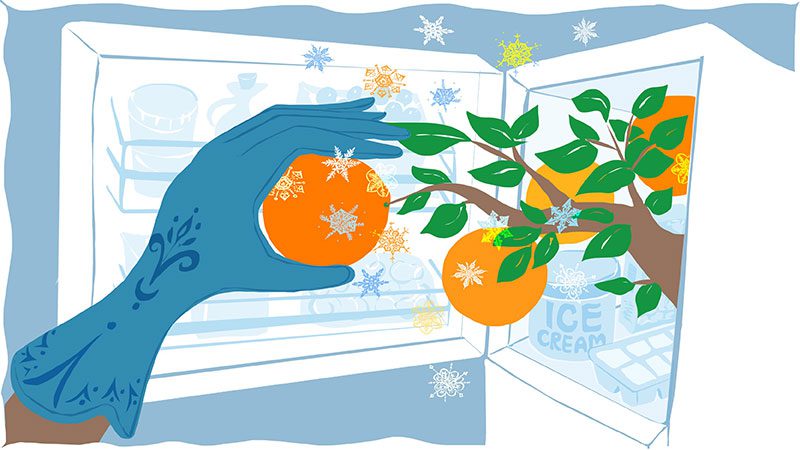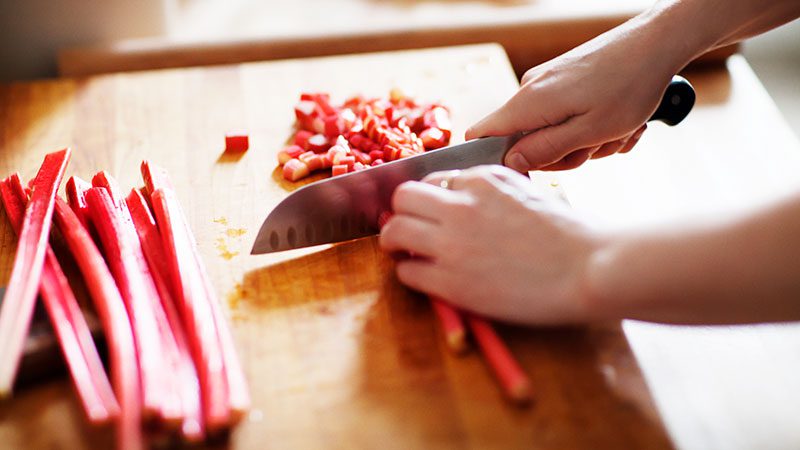How the freezer became my superpower
By Tara Austen Weaver, guest contributor

Illustration by Wendy Wahman
I believe we all have our superpowers. Some people are athletes, others are mathletes, and a few can do the Rubik’s Cube in their sleep. But I’ve always known the magic I make takes place in the kitchen, and the contents of my freezer are my true super power. Yours could be the same for you.
FREEZING citrus and more
It started ten years ago, when I drove back from California with a crate of Meyer lemons picked fresh off a friend’s backyard tree. Fragrant lemons feel precious in the middle of a Northwest winter and I wanted to preserve as much as possible. I started squeezing and freezing the juice in ice cube trays. And because much of the flavor is in the peels, I put those in freezer storage as well.
Do you know how nice it is never to run out of lemon juice or zest? And the frozen peels grate much easier than fresh. I started freezing lime and orange rinds as well, using them in baking projects, grain dishes, and stews.
I began to wonder what else I could freeze and never run out of—and welcomed chunks of ginger, lemongrass stalks, and lime leaves to my freezer shelves. My desire for Thai curries was now easily satisfied, and I discovered frozen ginger also grates better than fresh.
I was in my early days of gardening, with an assortment of herbs that grew lush and abundant—but only in the warmer months. Once you’ve broken free of paying for herbs in plastic clamshell packaging, it’s hard to go back. Could I preserve a seasonal bounty of basil, parsley, and chives to enjoy year-round? It took a little finessing, but the answer was yes.
Basil can be whirled into pesto and frozen (some say skip the parmesan, but I never do). The leaves themselves can be layered in olive oil in ice cube trays and frozen as well. When frozen, you can pop them out to stash in a zip-top bag or wide-mouth glass Mason jars. A dollop of either tossed into hot pasta turns plain noodles into a meal.
My favorite method for parsley comes from garden writer Margaret Roach, who de-stems leaves, fills up zip-top freezer bags, then compresses them into a log at the bottom of the bag. The air can be squeezed out and the bag rolled around the log. Now, when I want parsley, I cut a slice off the log (this method works for chives as well). Frozen herbs don’t have the same texture as fresh, but added to soups, stews, and grain dishes it’s hard to tell a difference, and they can be whisked into salad dressing as well.

Freezing fruits and baked goods
When I moved to a house with fruit trees and berry bushes, the freezer filled with blueberries, raspberries, strawberries, and rhubarb. I cut up pears, plums, and peaches each summer and stash them away, kiwi berries and cherries as well (ordered from a farm in eastern Washington). Catching fruit at the peak of ripeness means it is sweeter and more flavorful than anything you could buy mid-winter.
Frozen fruits can go into smoothies, but also, if unexpected visitors arrive I can pull a bubbling fruit crisp out of the oven in about an hour (I pre-make crisp topping and freeze that as well). It’s a pretty good party trick.
Fruit crisps are just the beginning of the baked goods that live in my freezer. Muffins, scones, banana bread, quiche, and frittata make for an easy breakfast. There are balls of homemade cookie dough, pie dough, and brownies for snacks.
There are also waffles and pancakes, which can be reheated in the toaster oven. I make double batches and freeze extras to stock up for times when I’m busy or don’t want to cook. It’s also possible to freeze cooked slices of bacon. Overnight guests are impressed when you pull a full breakfast out of your oven in about ten minutes, reheated while you brew coffee and put out juice. Super indeed!
Saving time and effort
My freezer is full of some of the things anyone might have—frozen peas, green beans, ground meat, pizza dough (store bought or homemade). I freeze bread crusts to grind into bread crumbs, and cook extra beans and grains to freeze for future meals. The ability to make fried rice at the drop of a hat has redeemed many a tired weeknight.
That is where my freezer storage super powers really shine—when I need to save myself. The batches of frozen soup comfort (avoid recipes with potatoes or cream bases), or containers of polenta with roasted vegetables, are warm and filling. The homemade dumplings and frozen burritos I make and stash away improves a lackluster day. What good is a super power when it doesn’t make you feel better?
My burritos bake up from frozen in thirty minutes while I walk the dog, and I come home to a warm meal I technically made myself, but it feels like someone else is taking care of me. Containers of chicken-ginger congee I hide away for when I’m sick nurse me through colds and flus. And to bring it back to Meyer lemons, the batches of lemon curd—and raspberry and strawberry curd—I make turn into a thick frozen custard; a spoonful does wonders to soothe a sore throat (ask me how I know).
It’s not only my own hard times the freezer aids. Friends facing challenges sometimes find a bag of frozen burritos or tamales, or a quart or two of soup and home baked bread left at their doorstep. Sure, delivery food exists, but there are times when even thinking about what to eat and how to procure it feels like work. For those times there is freezer soup, made with care.
Of course, every super power has its kryptonite, and my freezer is no exception. With storms increasing in strength and regularity, and the accompanying power outages, I’m looking into procuring a backup generator. I don’t want to lose my freezer storage bounty to inclement weather and downed power lines.
If it ever comes to that, however, I’d certainly be able to heat up an impressive spread for any hungry utility repair workers or neighbors. After all, there’s more than one way to save the day.
Seattle writer Tara Austen Weaver is a trained master gardener and author of several books, including “Orchard House: How a Neglected Garden Taught One Family to Grow,” “Growing Berries and Fruit Trees in the Pacific Northwest,” “A Little Book of Flowers: Tulips, Peonies and Dahlias,” and “A Little Book of Hummingbirds.”
Tips for Freezer Storage:
- Zip-top freezer-weight bags are your friend. I use them for fruits and vegetables, baked goods, and herbs. For longer storage I double up and use two bags—and wash and reuse.
- Air is not your friend—squeeze out all excess air before sealing the bags. Some people upgrade to a vacuum sealer to avoid this problem, but I never have.
- Leave headspace. Liquids will expand when frozen, so make sure to leave an inch of space at the top. I put lids on loosely until the contents are fully frozen, then tighten up.
- Freezing in glass (my preference). Pyrex freezer-safe containers are great. Canning jars work well, especially those with straight sides (to use canning jars that have curved shoulders at the top you need to leave two inches headspace, so it’s not space efficient).
- Want to learn more about what you can and can’t do with frozen produce? Read all about cooking and baking with frozen fruit and vegetables in this recent Sound Consumer article.
